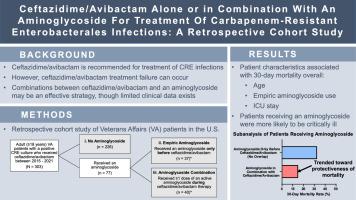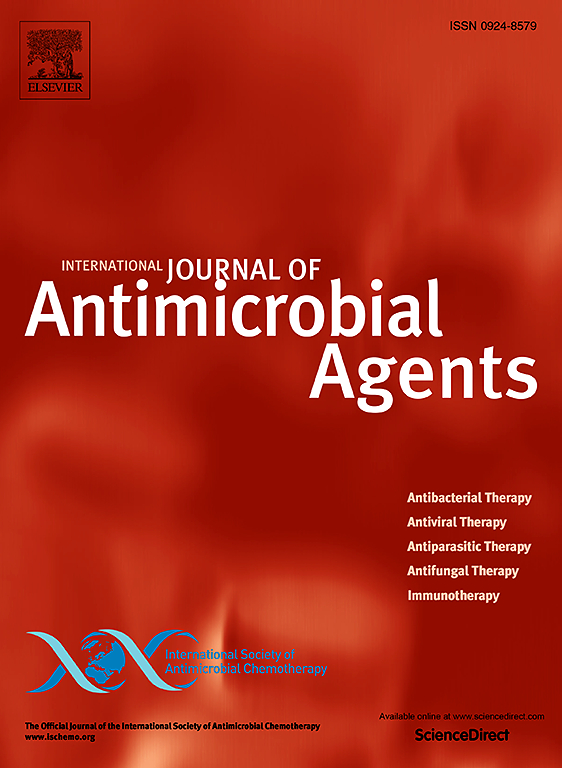Ceftazidime/avibactam alone or in combination with an aminoglycoside for treatment of carbapenem-resistant Enterobacterales infections: A retrospective cohort study
IF 4.9
2区 医学
Q1 INFECTIOUS DISEASES
International Journal of Antimicrobial Agents
Pub Date : 2024-09-05
DOI:10.1016/j.ijantimicag.2024.107321
引用次数: 0
Abstract
Background
Ceftazidime/avibactam is one of the preferred treatment options for carbapenem-resistant Enterobacterales (CRE). However, the benefit of combining ceftazidime/avibactam with another antibiotic remains unclear.
Objectives
To identify variables associated with treatment failure during the use of ceftazidime/avibactam for CRE infections and assess the effect of combining an aminoglycoside with ceftazidime/avibactam.
Methods
This was a retrospective cohort study of patients with a positive CRE culture treated with ceftazidime/avibactam between 2015 and 2021 in 134 Veterans Affairs (VA) facilities. The primary outcome was 30-day mortality and the secondary outcome was in-hospital mortality. A subanalysis in patients who received an aminoglycoside was also performed.
Results
A total of 303 patients were included. The overall 30-day and in-hospital mortality rates were 12.5% and 24.1%, respectively. Age (aOR 1.052, 95% CI 1.013–1.093), presence in the ICU (aOR 2.704, 95% CI 1.071–6.830), and receipt of an aminoglycoside prior to initiation of ceftazidime/avibactam (aOR 4.512, 95% CI 1.797–11.327) were independently associated with 30-day mortality. In the subgroup of patients that received an aminoglycoside (n = 77), their use in combination with ceftazidime/avibactam had a 30-day mortality aOR of 0.321 (95% CI, 0.089–1.155).
Conclusion
In veterans treated with ceftazidime/avibactam for CRE infections, increased age, receipt of an empiric aminoglycoside, and presence in the ICU at the time of index culture were associated with higher 30-day mortality. Among patients who received an aminoglycoside, their use in combination with ceftazidime/avibactam trended toward protectiveness of 30-day mortality, suggesting a potential role for this combination to treat CRE infections in patients who are more severely ill.

头孢他啶/阿维菌素单独或与氨基糖苷类药物联合治疗耐碳青霉烯类肠杆菌感染:一项回顾性队列研究。
背景:头孢他啶/阿维巴坦是治疗耐碳青霉烯类肠杆菌(CRE)的首选药物之一。然而,头孢他啶/阿维巴坦与另一种抗生素联合使用的益处仍不明确:确定在使用头孢他啶/阿维巴坦治疗CRE感染期间与治疗失败相关的变量,并评估氨基糖苷类药物与头孢他啶/阿维巴坦联合使用的效果:这是一项回顾性队列研究,研究对象是2015年至2021年间在134个退伍军人事务(VA)机构中接受头孢他啶/阿维巴坦治疗的CRE培养阳性患者。主要结果是 30 天死亡率,次要结果是院内死亡率。此外,还对接受氨基糖苷类药物治疗的患者进行了亚分析:结果:共纳入 303 名患者。30天和住院总死亡率分别为12.5%和24.1%。年龄(aOR 1.052,95% CI 1.013-1.093)、是否住在重症监护室(aOR 2.704,95% CI 1.071-6.830)、开始使用头孢他啶/阿维巴坦前是否使用过氨基糖苷类药物(aOR 4.512,95% CI 1.797-11.327)与 30 天死亡率有独立关联。在接受氨基糖苷类药物治疗的亚组患者(77人)中,与头孢他啶/阿维巴坦合用氨基糖苷类药物的30天死亡率aOR为0.321(95% CI,0.089-1.155):在使用头孢他啶/阿维巴坦治疗CRE感染的退伍军人中,年龄增大、接受过氨基糖苷类药物治疗以及在进行指数培养时身处重症监护室与30天死亡率升高有关。在接受氨基糖苷类药物治疗的患者中,与头孢他啶/阿维巴坦联合使用可降低30天死亡率,这表明这种联合用药可用于治疗病情较重患者的CRE感染。
本文章由计算机程序翻译,如有差异,请以英文原文为准。
求助全文
约1分钟内获得全文
求助全文
来源期刊
CiteScore
21.60
自引率
0.90%
发文量
176
审稿时长
36 days
期刊介绍:
The International Journal of Antimicrobial Agents is a peer-reviewed publication offering comprehensive and current reference information on the physical, pharmacological, in vitro, and clinical properties of individual antimicrobial agents, covering antiviral, antiparasitic, antibacterial, and antifungal agents. The journal not only communicates new trends and developments through authoritative review articles but also addresses the critical issue of antimicrobial resistance, both in hospital and community settings. Published content includes solicited reviews by leading experts and high-quality original research papers in the specified fields.

 求助内容:
求助内容: 应助结果提醒方式:
应助结果提醒方式:


